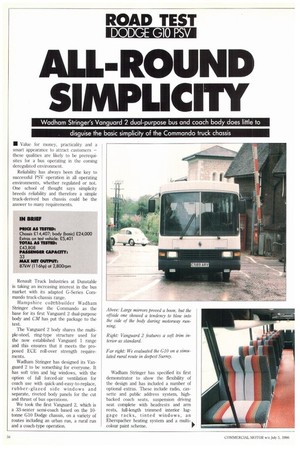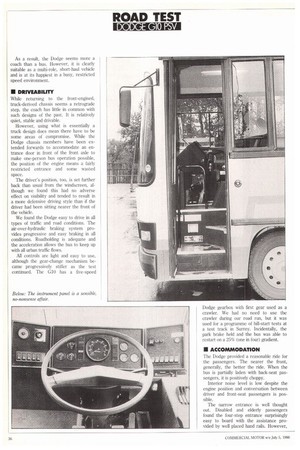ALL-ROUND SIMPLICITY
Page 36

Page 38

Page 39

If you've noticed an error in this article please click here to report it so we can fix it.
Wadham Stringer's Vanguard 2 dual-purpose bus and coach body does little to disguise the basic simplicity of the Commando truck chassis
• Value for money, practicality and a smart appearance to attract customers — these qualities are likely to be prerequisites for a bus operating in the coming deregulated environment.
Reliability has always been the key to successful NV operation in all operating environments, whether regulated or not. One school of thought says simplicity breeds reliability and therefore a simple truck-derived bus chassis could be the answer to many requirements.
Renault Truck industries at Dunstable is taking an increasing interest in the bus market with its adapted G-Series Commando truck-chassis range.
Hampshire ccathbuilder Wadham Stringer chose the Commando as the base for its first Vanguard 2 dual-purpose body and CM has put the package to the test.
'Ile Vanguard 2 body shares the multiple-steel, ring-type structure used for the now established Vanguard 1 range and this ensures that it meets the proposed ECE roll-over strength requirements.
Wadham Stringer has designed its Vanguard 2 to be something for everyone. It has soft trim and big windows, with the option of full forced-air ventilation for coach use with quick-and-easy-to-replace, rubber-glazed side windows and separate, riveted body panels for the cut and thrust of bus operations.
We took the first Vanguard 2, which is a 33-seater semi-coach based on the 10tonne G10 Dodge chassis, on a variety of routes including an urban run, a rural run and a coach-type operation. Wadham Stringer has specified its first demonstrator to show the flexibility of the design and has included a number of optional extras. These include radio, cassette and public address system, highbacked coach seats, suspension driving seat complete with headrests and arm rests, full-length trimmed interior luggage racks, tinted windows, an Eberspacher heating system and a multicolour paint scheme. As a result, the Dodge seems more a coach than a bus. However, it is clearly suitable as a multi-role, short-haul vehicle and is at its happiest in a busy, restricted speed environment.
• DRIVEABIUTY
While returning to the front-engined, truck-derived chassis seems a retrograde step, the coach has little in common with such designs of the past. It is relatively quiet, stable and drivable.
However, using what is essentially a truck design does mean there have to be some areas of compromise. While the Dodge chassis members have been extended forwards to accommodate an entrance door in front of the front axle to make one-person bus operation possible, the position of the engine means a fairly restricted entrance and some wasted space.
The driver's position, too, is set further back than usual from the windscreen, although we found this had no adverse effect on visibility and tended to result in a more defensive driving style than if the driver had been sitting nearer the front of the vehicle.
We found the Dodge easy to drive in all types of traffic and road conditions. The air-over-hydraulic braking system provides progressive and easy braking in all conditions. Roadholding is adequate and the acceleration allows the bus to keep up with all urban traffic flows.
All controls are light and easy to use, although the gear-change mechanism became progressively stiffer as the test continued. The G10 has a five-speed Dodge gearbox with first gear used as a crawler. We had no need to use the crawler during our road run, but it was used for a programme of hill-start tests at a test track in Surrey. Incidentally, the park brake held and the bus was able to restart on a 25% (one in four) gradient.
• ACCOMMODATION
The Dodge provided a reasonable ride for the passengers. The nearer the front, generally, the better the ride. When the bus is partially laden with back-seat passengers, it is positively choppy.
Interior noise level is low despite the engine position and conversation between driver and front-seat passengers is possible.
The narrow entrance is well thought out. Disabled and elderly passengers found the four-step entrance surprisingly easy to board with the assistance provided by well placed hand rails. However, the restricted width of the door and the width of the engine cover between the driver and boarding passengers will make one-person bus operation a little slow.
We felt that this would prove a real problem for operating in a busy, urban environment, but would not cause problems if the vehicle was operating as a country, school, works or private-hire bus or coach.
The demonstrator coach is fitted with a pivoted, powered-entrance door, which should prove equally suitable for bus and coach operations. No destination equipment is fitted to this particular vehicle although there is room to accommodate this above the windscreen.
While the test vehicle is certified to carry 33 seated passengers and no standing, the Dodge chassis would allow for a number of standees if required. The maximum plated weight of the G10 chassis is 9.7 tonnes. The unladen Vanguard 2 bodied example weighs in at just 6,395 tonnes. With 33 normal-weight passengers, the total vehicle weight is around 8.5 tonnes. If the necessary handrail and stanchions are fitted, the vehicle could well accommodate a reasonably high number of standees.
• PERFORMANCE One reason for bus operators buying midi or minibuses is to be able to operate services into housing areas impenetrable to conventional buses. The G10 is just a little large to be able to claim this advantage. It is in fact as long and as wide as many a double-decker.
It is, however, an unfussed bus, powered by a relatively unstressed and large naturally aspirated diesel.
The Perkins 6.354.4 engine used is a 5.8-litre unit rated to give 87kW (116hp) at 2,800rpm and 323Nm (238 lb ft) at 1,500 rpm. With the standard manual gearbox, the bus can accelerate from 050km/h in 22.7 seconds and has a maximum speed of 102.5kmih.
We found that the Dodge returned an encouraging fuel consumption figure of 23.51it/100km (12mpg) on a typical rural route, 24.1 lit/100km (11.7mpg) on a busy urban route and 20.91it/100km (13.5mpg) on a section of motorway running.
• SUMMARY For a newcomer starting a bus service from scratch, buying such a bus could be a practical proposition. Renault Truck Industries has a good spread of dealers able to offer full, planned maintenance contracts for periods of two and five years. Spare parts are readily available and repairs will prove straightforward. With its air-over-hydraulic brakes, steel springs and large, front-mounted engine, the G10 chassis is not "state of the art." It is competitive in price and provides a satisfactory travel product for the bus or short-haul coach passenger.
Wadham Stringer's Vanguard 2 can give the best of both worlds. Members of the public perceive it as a luxury coach owing to its fashionable soft trim and its European styling complete with its square-cornered "bonded look", rubberglazed windows.
From the operator's point of view the body is easier to repair than most frontline coach bodies. It has separate, easyto-replace aluminium side panels and there is no down-time waiting for glue to set in the event of a window needing replacement.
If it is used for tendered routes it can always be integrated into coaching duties if its owner loses contracts. This also gives an operator the flexibility to innovate without risking buying vehicles likely to prove expensive white elephants.
Vanguard 2 is available on a number of chassis as well as the Dodge range. Wadham Stringer has orders for the body on Bedford and Dennis chassis and will build on what its customer wants provided it is technically compatible.
The advantages and disadvantages of the Dodge G10 are less clear cut. It is economically priced and should prove cheap to operate. It cannot compare with many mid-engined and rear-engined bus designs in terms of passenger comfort, although it provides an acceptable standard of ride and performance.
In the long term the unstressed Dodge could prove to be the type of vehicle with a naturally long-life potential because of its robust simplicity. However, it is probably the smaller Dodge GOB that will interest more bus operators since it is better able to penetrate into areas denied to full-size buses and take advantage of the present rnidibus boom. Allison automatic transmission is optional.
by Noel Waller




































































































